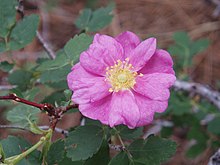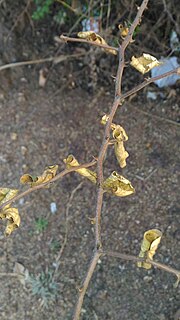
Rosa chinensis, known commonly as the China rose or Chinese rose, is a member of the genus Rosa native to Southwest China in Guizhou, Hubei, and Sichuan Provinces. The first publication of Rosa chinensis was in 1768 by Nikolaus Joseph von Jacquin in Observationum Botanicarum, 3, p. 7, p. 55.
Horkelia bolanderi is a rare species of flowering plant in the rose family known by the common names border horkelia and Bolander's horkelia. It is endemic to northern California where it is known from only a few occurrences in two or three counties. It grows in the mountain forests of the North Coast Ranges. This is a mat-forming gray-green perennial herb producing hairy erect stems 10 to 30 centimeters tall. The leaves are 3 to 8 centimeters long and are made up of hairy, toothed leaflets each one half to one centimeter long. The inflorescence holds several flowers, each with five white petals and up to 20 pistils in the center.

Horkelia californica, known by the common name California horkelia, is a species of flowering plant in the rose family.

Horkelia marinensis is a rare species of flowering plant in the rose family known by the common name Point Reyes horkelia. It is endemic to the California coastline, where it is known from about Fort Bragg to near Santa Cruz. It grows on beaches and in other sandy coastal areas. This is a perennial herb growing in low, dense patches. The leaves are up to 10 centimeters long and are made up of toothed, hairy, gray-green leaflets each around a centimeter long. The foliage is glandular and strongly scented. The plant produces green to reddish-green stems up to 30 centimeters long which bear inflorescences of dense clustered flowers. Each flower has minute bractlets under reddish-green, fuzzy sepals. The petals are generally white and narrow with rounded ends. The center of the flower contains a ring of stamens around a patch of 20 to 30 pistils.
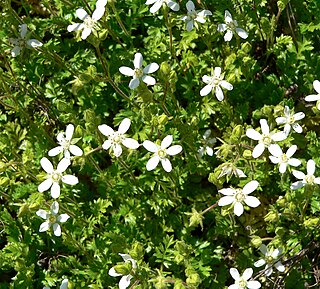
Horkelia parryi is a species of flowering plant in the rose family known by the common name Parry's horkelia. It is endemic to California, where it grows in the chaparral of the Sierra Nevada foothills. This is a low, mat-forming perennial herb growing in unobtrusive green patches on the ground. The leaves are 5 to 10 centimeters long and are each made up of small, toothed, oval-shaped leaflets. The somewhat hairy green to reddish-green stems are 10 to 30 centimeters long and bear inflorescences of a few flowers each. The flower has minute bractlets under larger, pointed sepals and five white petals. The center of the flower contains a ring of stamens around a patch of up to 50 thready pistils.
Horkelia sericata is a species of flowering plant in the rose family known by the common names silky horkelia and Howell's horkelia. It is native to the Klamath Mountains of northern California and southern Oregon, where it grows in the chaparral and forest, often on serpentine soils. This is a perennial herb growing in small tufts of erect leaves and stems. The leaves are 3 to 15 centimeters long and are each made up of herringbonelike rows of small, tightly packed leaflets. The green leaflets bear long, silky white hairs, giving the plant a silvery green look. The green, brown, or reddish stems reach up to 50 centimeters long and bear loose inflorescences of many flowers. The flower has small green sepals covered in luxuriant white hairs, and white or pink-tinted petals with two-lobed tips.
Horkelia tularensis is a species of flowering plant in the rose family known by the common name Kern Plateau horkelia. It is endemic to Tulare County, California, where it is known from about ten occurrences in the High Sierra Nevada. It grows in rocky, exposed areas. This is a mat-forming perennial herb producing clumps of short, erect leaves and stems. The leaves are up to about 10 centimeters long and are made up of small closely packed leaflets. The foliage is covered in hairs that give the plant a light gray-green color. Stems grow to about 20 centimeters in maximum height and hold inflorescences of several flowers each. The flower has pointed green sepals up to half a centimeter long and shorter, narrow white petals.
Ivesia muirii is a species of flowering plant in the rose family known by the common name granite mousetail. It is endemic to the High Sierra Nevada of California, where it grows on rocky slopes and cliffs.
Ivesia paniculata is a species of flowering plant in the rose family known by the common name Ash Creek mousetail, or Ash Creek ivesia. It is endemic to the Modoc Plateau of Lassen and Modoc Counties in the northeastern corner of California, where it is known only from the vicinity of Ash Valley. It was first described in 1981. This is a small perennial herb of sage scrub on volcanic soils and rocky slopes. It forms a matted clump from a woody caudex and produces leaves and stems which lie on the ground or are somewhat erect. Each leaf is about 2 to 5 centimeters long and is made up of rows of many tiny, lobed, pink-edged green leaflets, densely coated in short white hairs. The leaflets overlap such that each leaf is cylindrical. The mostly naked pinkish stems bear inflorescences of hairy clusters of flowers. Each flower is about half a centimeter wide and has hairy pink-edged greenish sepals and tiny pale yellow petals. There are five stamens and a few pistils.
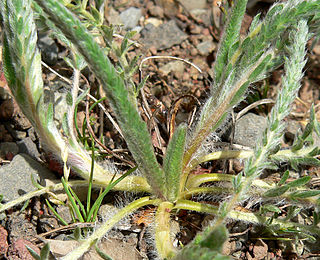
Ivesia sericoleuca is a species of flowering plant in the rose family known by the common name Plumas mousetail, or Plumas ivesia.

Ivesia webberi is a species of flowering plant in the rose family known by the common names wire mousetail and Webber's ivesia. It is native to the United States, where it occurs in the northernmost part of the Sierra Nevada and the adjacent Modoc Plateau in California, its range extending just into Nevada.
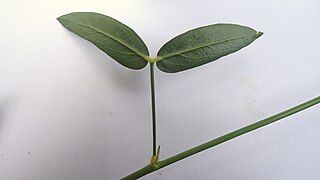
Zornia latifolia is a species of flowering plant in the legume family, Fabaceae. It is native to South America. Its distribution may extend into Central and North America. It is also known as a naturalized species in tropical western Africa. The plant is known commonly as maconha brava.

Astragalus purshii is a species of milkvetch known by the common names woollypod milkvetch and Pursh's milkvetch.
Lupinus brevicaulis is a species of lupine known by the common names shortstem lupine and sand lupine. It is native to the southwestern United States and Great Basin area and into northern Mexico, where it grows in many types of sandy habitat. This is a hairy annual herb growing nearly flat in a spread on the ground with a stem just a few centimeters long. An array of leaves encircles the base. Each palmate leaf is made up of 6 to 8 leaflets about a centimeter long and a few millimeters in width. The inflorescence is a petite spiral of flowers a few centimeters long just arising past the basal disc of leaves. Each flower is 6 to 8 millimeters long and bright blue in color, generally with a white or yellowish spot on its banner. The fruit is a hairy legume pod about a centimeter long containing 1 or 2 beanlike seeds.
Pediomelum castoreum is a species of flowering plant in the legume family known by the common names beaver Indian breadroot and beaver dam breadroot. It is native to the deserts around the intersection of California, Nevada, and Arizona, where it grows in local habitat including disturbed areas. It is a perennial herb with no stem or a short stem that is mostly underground, leaving the plant at ground level. The compound leaves are each made up of five or six oval leaflets which may be over 4 centimeters long. The leaf is borne on a long petiole. The inflorescence is a raceme of several blue or purple pealike flowers each roughly a centimeter long. The fruit is a hairy oval legume pod tipped with a long, curved beak. It contains ridged gray seeds each about 6 millimeters long.
Rosa bridgesii is a species of rose known by the common names pygmy rose and Sierran dwarf rose. It is native to California, where it grows in the forests of the Sierra Nevada and surrounding mountains and foothills. It may also occur in Oregon.
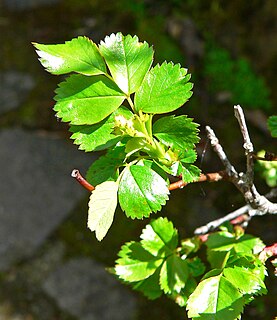
Rosa pisocarpa is a species of rose known by the common name cluster rose or swamp rose. It is native to western North America from British Columbia to northern California, where it generally grows in moist habitats. It is a shrub sometimes forming a thicket, and growing up to 2.5 meters tall. The stems can be dark red or blackish and are often studded with straight, paired prickles at nodes. The leaves are each made up of several toothed oval leaflets, the terminal leaflet up to 4 centimeters long. The inflorescence is a cyme of up to 10 flowers with pink petals each up to 2 centimeters in length. The fruit is a rose hip about a centimeter wide. The hips are pear- or egg-shaped and borne in clusters, and are decorative in fall and early winter, when they are red or reddish-purple and contrast with yellow foliage. Fall foliage can be yellow or dark red.

Rosa woodsii is a species of wild rose known by the common names Woods' rose, and interior rose.
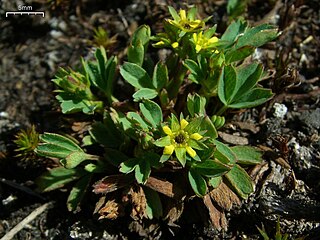
Sibbaldia procumbens is a species of flowering plant in the rose family known by the common name creeping sibbaldia. It has a circumpolar distribution; it can be found throughout the northern latitudes of the Northern Hemisphere from Arctic regions into higher-elevation temperate areas. It grows on tundra and in alpine climates where snow remains year-round, and on subalpine mountain slopes. This is a low, mat-forming perennial herb producing clumps of herbage in rocky, gravelly substrate. A spreading stem up to 15 centimeters long grows from a caudex. Each leaf is divided into usually three leaflets borne at the end of a petiole up to 7 centimeters long. Each wedge-shaped leaflet has three teeth at the tip. The flower has usually five pointed green bractlets, five wider pointed green sepals, and five tiny yellowish petals each about a millimeter long. The fruits develop in the remnants of the sepals on erect stalks.
Polemonium pectinatum is a species of flowering plant in the phlox family known by the common names Washington Jacob's-ladder and Washington polemonium. It is endemic to the state of Washington in the United States, where it occurs in the Columbia Basin, including the Channeled Scablands and the Palouse.
